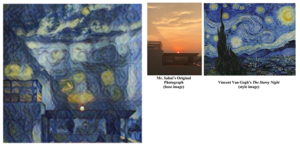Accuracy, context, cultural sensitivity, and an awareness of how things can go wrong are all part of an ethical approach to using images. Codes of professional ethics encourage awareness and condemn news manipulation.
Many of the problems come up due to political or racial prejudices, as some of the following examples show. It’s important to emphasize that journalists and media professionals are responsible for avoiding hateful speech.
Artificial intelligence and images is also a growing concern.
The image on the left was denied copyright registration in December 2023 because it lacked originality.
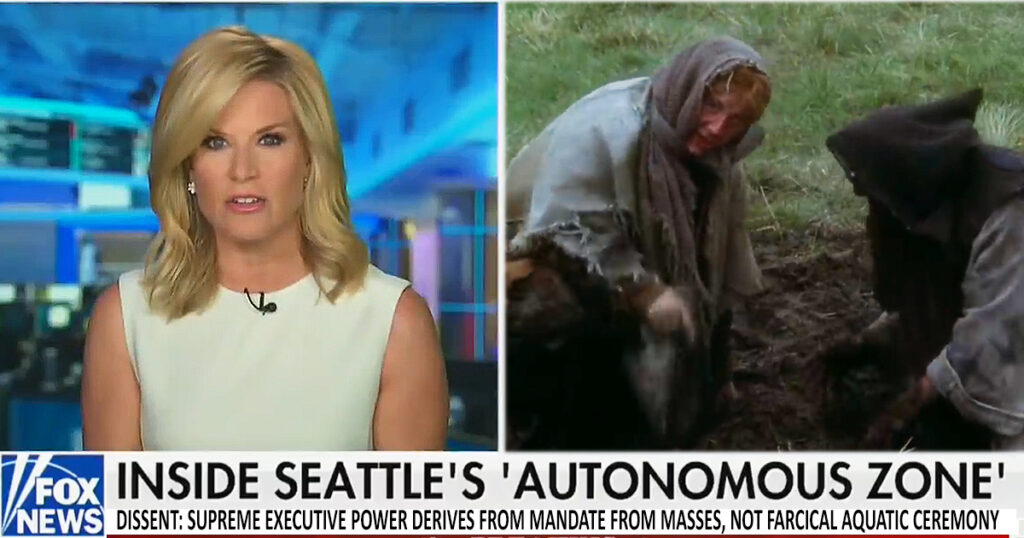
Fox News takes Reddit post seriously.
In a story about a temporary “autonomous zone” in Seattle, Fox News fell for a Monty Python joke. Here Martha MacCallum reads from a Reddit post about just how grim things have become in the zone during the confrontations of the summer of 2020. The picture on screen and the text of the news report are both from the 1975 movie, Monty Python and the Holy Grail, a light comedy about the Dark Ages.
Volkswagen Golf, 2020 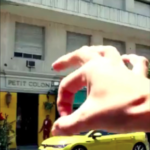 Volkswagen’s racist ad from May 2020 “horrified” management when they realized what their agency had done. A company official apologized and called it “an insult to every decent person.” The 10-second clip depicted a pair of oversize white hands dragging a black man away from a new VW Golf 8 sedan, and flicking him violently into a restaurant called “Petit Colon,” a name with overtones of colonization. Briefly as a spokeswoman reads the phrase “Der Neue Golf,” or “the new Golf,” as it appears on the screen, the letters materialize in an order that briefly spells the German n-word.
Volkswagen’s racist ad from May 2020 “horrified” management when they realized what their agency had done. A company official apologized and called it “an insult to every decent person.” The 10-second clip depicted a pair of oversize white hands dragging a black man away from a new VW Golf 8 sedan, and flicking him violently into a restaurant called “Petit Colon,” a name with overtones of colonization. Briefly as a spokeswoman reads the phrase “Der Neue Golf,” or “the new Golf,” as it appears on the screen, the letters materialize in an order that briefly spells the German n-word.
Dove Soap apologized in 2017 after an ad was published that showed an African American woman using Dove Soap and then turning White. This is an old racist trope more at home in the 1870s than the 21st century.
Yom Kippur news graphic, 2015  Another highly insensitive media faux-pas was this use of a Nazi concentration camp emblem as an illustration for a 2015 story about the Jewish holiday Yom Kippur. This is one obvious reason that an education in the humanities is crucial for journalists and media professionals.
Another highly insensitive media faux-pas was this use of a Nazi concentration camp emblem as an illustration for a 2015 story about the Jewish holiday Yom Kippur. This is one obvious reason that an education in the humanities is crucial for journalists and media professionals.
Iowa newspaper mug shots, 2015 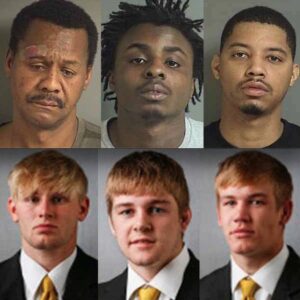 Racism is often built into the crime reporting system. For example, this selection of mug shots to illustrate arrest stories appeared in March of 2015 in the Cedar Rapids Iowa Gazette newspaper. The Gazette reported on two groups of people who were arrested for two burglaries. The police mug shots of the Black group were posted, while yearbook pictures were posted for the White group. After this comparison showed up in social media, the Gazette went back to the police department and got the mug shots for the White group.
Racism is often built into the crime reporting system. For example, this selection of mug shots to illustrate arrest stories appeared in March of 2015 in the Cedar Rapids Iowa Gazette newspaper. The Gazette reported on two groups of people who were arrested for two burglaries. The police mug shots of the Black group were posted, while yearbook pictures were posted for the White group. After this comparison showed up in social media, the Gazette went back to the police department and got the mug shots for the White group.
Olympics, 2021: One example of stereotyping took place during the opening ceremonies of the 2021 Olympics, when a South Korean television station broadcast stereotypical images “to help viewers quickly identify each country.” The station broadcast pictures of salmon fish for Norway, the Chernobyl disaster for Ukraine, and demonstration on a burning street for Haiti. Representatives of those countries objected and the TV station apologized. Also at the 2021 Olympics, the coordinator of the opening ceremonies was fired after making public jokes about the European Holocaust, in which more than six million Jewish people were murdered by Nazis in the 1930s and 40s.
Reports on Asiana Flight 214 – 2013  Racism and racial slurs are deeply objectionable even in the context of a “joke.” Reporting on the crash of Asiana flight 214 in the summer of 2013, TV news reporters were fooled into using names of the crew that included “Sum Ting Wong, Wi Tu Lo, Ho Lee Fuk, and Bang Ding Ow.”
Racism and racial slurs are deeply objectionable even in the context of a “joke.” Reporting on the crash of Asiana flight 214 in the summer of 2013, TV news reporters were fooled into using names of the crew that included “Sum Ting Wong, Wi Tu Lo, Ho Lee Fuk, and Bang Ding Ow.”
Hurricane Katrina photo captions 2003 show racism
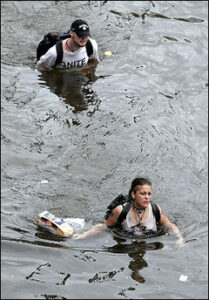 Two residents wade through chest-deep water after finding bread and soda from a local grocery store after Hurricane Katrina came through the area in New Orleans, Louisiana.(AFP/Getty Images/Chris Graythen) |
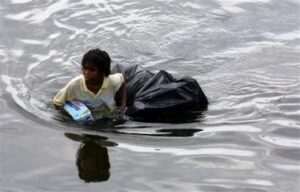 A young man walks through chest deep flood water after looting a grocery store in New Orleans on Tuesday, Aug. 30, 2005. Flood waters continue to rise in New Orleans after Hurricane Katrina did extensive damage when it made landfall on Monday. (AP Photo/Dave Martin) |
PHOTO MANIPULATION
Photo manipulation presents us with ethical dilemmas of varying degrees of severity. In some cases, the photographers or editors are fired when unethical images are used. In other cases, such as the magazine cover from the Economist, the ethical issue is debatable.
 The Economist magazine, 2010, isolated then-president Barack Obama in a cover photo. The original is to the right. The Economist is implying that Obama was bowed down by the weight of the controversy when, at least in the original photo, he was bending down to listen to someone. |
|
OJ Simpson, Newsweek and Time, 1994
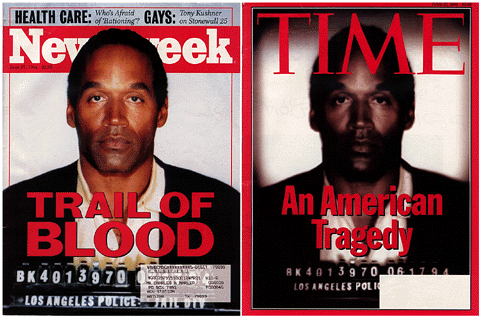 Did Time Magazine act unethically when it darkened the face of OJ Simpson to make him seem more sinister? |
|
Kent State massacre photo, 1970
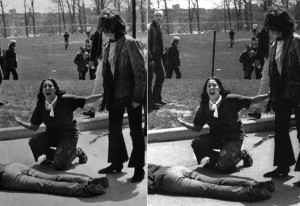 This 1970 Pulitzer-prize winning photo by John Filo depicts Mary Ann Vecchio at the Kent State Campus reacting just after National Guard troops killed 20-year-old Jeffrey Miller. The version on the right, with the apparent “merger” of a fence post with the top of Vecchio’s head, is actually the original. The version on the left has the fence post airbrushed out, which is not ethical in a news photo. |
|
War in Iraq 2003 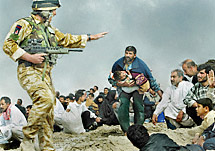 This first photo is a composite in which a soldier appears to be telling a man with a child in distress to sit down. The two photos from which this is drawn tell a different story. The photographer responsible for these photos was dismissed from the LA Times two days after the composites came to light. This first photo is a composite in which a soldier appears to be telling a man with a child in distress to sit down. The two photos from which this is drawn tell a different story. The photographer responsible for these photos was dismissed from the LA Times two days after the composites came to light. |
|
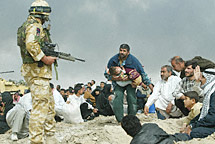 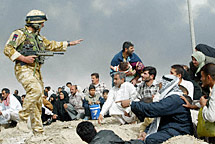   |
|
Fox digital manipulation, 2020
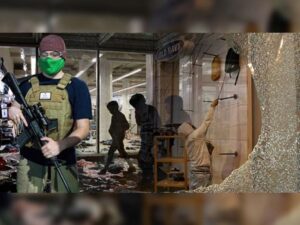 On June 12, 2020, Fox television resented this and several other digitally manipulated images to make civil protests look like riots in June 2020. Fox claimed it was a simple error, but it was clearly unethical. |
Resources
- National Press Photographers Code of Ethics Editing should maintain the integrity of the photographic images’ content and context. Do not manipulate images or add or alter sound in any way that can mislead viewers or misrepresent subjects.”
- Associated Press. AP pictures must always tell the truth. We do not alter or manipulate the content of a photograph in any way. The content of a photograph must not be altered in PhotoShop or by any other means. No element should be digitally added to or subtracted from any photograph. The faces or identities of individuals must not be obscured by PhotoShop or any other editing tool. Only retouching or the use of the cloning tool to eliminate dust and scratches are acceptable. Minor adjustments in PhotoShop are acceptable… (but) … Changes in density, contrast, color and saturation levels that substantially alter the original scene are not acceptable. Backgrounds should not be digitally blurred or eliminated by burning down or by aggressive toning.
- Reuters: No additions or deletions to the subject matter of the original image. (thus changing the original content and journalistic integrity of an image). No excessive lightening, darkening or blurring of the image (thus misleading the viewer by disguising certain elements of an image). No excessive colour manipulation. (thus dramatically changing the original lighting conditions of an image). Only minor Photoshop work should be performed in the field (especially from laptops). We require only cropping, sizing and levels with resolution set to 300 dpi. Where possible, ask your regional or global picture desks to perform any required further Photo-shopping on their calibrated hi-resolution screens…
- Photographer’s Guide to Privacy by the Reporters Committee for Freedom of the Press

